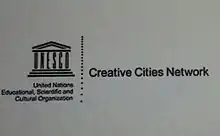Creative Cities Network
The UNESCO Creative Cities Network (UCCN) is a flagship city programme of UNESCO launched in 2004 to promote cooperation among cities which have recognized culture and creativity as strategic drivers of sustainable urban development.[1][2][3] As of 2022, there are almost 300 cities from around 90 countries in the network.

The network aims to foster mutual international cooperation with and between member cities committed to invest in creativity as a driver for sustainable urban development, social inclusion and cultural vibrancy.[4] The Network recognizes the following creative fields:[1]
- The overall situation and activities within the Network is reported in the UCCN Membership Monitoring Reports, each for a 4-year period for a particular city.[5]
- The Network recognizes the concept of creative tourism, defined as travel associated with creative experience and participation.[6]
Film
Literature
Music
Crafts and Folk Arts
Design
UNESCO's Design Cities project is part of the wider Creative Cities Network. To be approved as a Design City, cities need to meet a number of criteria set by UNESCO.[7] The Design Cities are:[8]
| Year | Inscriptions | Cities | Reference |
|---|---|---|---|
| 2005 | 1 | Buenos Aires | [9] |
| 2006 | 2 | Berlin, Montreal | [10][11] |
| 2008 | 3 | Kobe, Nagoya, Shenzhen | [12][13][14] |
| 2010 | 3 | Saint-Etienne, Seoul, Shanghai | [15][16][17] |
| 2011 | 1 | Graz | [18] |
| 2012 | 1 | Beijing | |
| 2014 | 5 | Bilbao, Helsinki, Turin, Dundee, Curitiba | [19][20][21][22] |
| 2015 | 5 | Bandung, Detroit, Puebla, Singapore, Kaunas | |
| 2017 | 4 | Geelong, Kortrijk, Istanbul, Wuhan | |
| 2019 | 9 | Asahikawa (Japan), Baku (Azerbaijan), Bangkok (Thailand), Cebu City (Philippines), Fortaleza (Brazil), Hanoi (Vietnam), Muharraq (Bahrain), Querétaro (Mexico) and San José (Costa Rica) | [23] |
Gastronomy
Media Arts
Guadalajara (Mexico) became a UNESCO Creative City of Media Arts in 2017.[24]
York (UK) became a UNESCO Creative City of Media Arts in 2014.[25]
References
- "What is the Creative Cities Network ?", a UNESCO webpage
- Creative Cities Network homepage
- Inequalities in Creative Cities: Issues, Approaches, Comparisons, 2016, ISBN 1349951153 p. 241
- "UCCN today: 116 Cities in 54 countries | Creative Cities Network". en.unesco.org. Retrieved 2018-10-03.
- "Reporting & monitoring", a UCCN webpage
- OECD Studies on Tourism Tourism and the Creative Economy, 2014, ISBN 9264207872, p. 83
- "The Creative Cities Network - A Global Platform for Local Endeavour" (PDF). UNESCO. Retrieved 2019-11-05.
- "Design Cities". Cities of Design Network. Retrieved 2019-11-05.
- "Buenos Aires". UNESCO. Retrieved 2022-01-19.
- "Berlin}". UNESCO. Retrieved 2022-01-19.
- "Montreal". UNESCO. Retrieved 2022-01-19.
- "Nagoya". UNESCO. Retrieved 2022-01-19.
- "Shenzhen".
- "Kobe".
- "Saint-Etienne".
- "Seoul".
- "Shanghai".
- "Graz".
- "Helsinki". Archived from the original on 2020-08-04. Retrieved 2022-01-19.
- "Torino". Archived from the original on 2019-07-23.
- "Bilbao".
- "Curitiba".
- "UNESCO celebrates World Cities Day designating 66 new Creative Cities". UNESCO. 2019-10-30. Retrieved 2019-11-05.
- "Guadalajara | Creative Cities Network". en.unesco.org. Retrieved 2023-01-01.
- "York | Creative Cities Network". en.unesco.org. Retrieved 2019-11-09.
External links
- Official website
 UNESCO Creative Cities travel guide from Wikivoyage
UNESCO Creative Cities travel guide from Wikivoyage